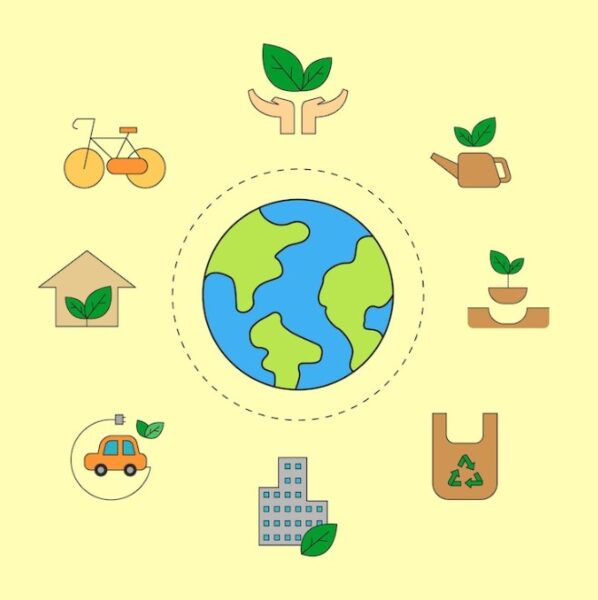
Your carbon footprint is the quantity of greenhouse gases you generate through your actions. Even though businesses are responsible for the great majority of carbon emissions, you can still make a difference in the globe. Though it may seem difficult, reducing your carbon footprint is actually rather simple. Many of the most significant adjustments you can make come down to very small lifestyle adjustments and the use of greener technology. Reduce you carbon footprint and contribute to the continued well-being of our planet.
Before we can start reducing, we must first understand what we are creating. The quantity of greenhouse gases, especially carbon dioxide, released by human actions during a specified time period is referred to as our "carbon footprint."
There are three categories of carbon emissions:
- Direct emissions from owned and managed resources are referred to as scope 1 emissions.
- Indirect emissions from the production of energy that has been obtained from a utility provider are known as scope 2 emissions.
- All indirect emissions that occur in the value chain that are not covered by scope 2 are considered scope 3 emissions, including both upstream and downstream emissions.
What do these scopes entail for each of us personally, then? The best course of action is to 1) gain a general understanding of your carbon footprint, 2) try to reduce it wherever you can by changing your travel habits, and 3) enrol in third-party certified programmes to actively mitigate it. You can certainly delve deeper to learn more about this complex topic.
You can take action once you have a better understanding of how your emissions are produced.
1. Drive less
whenever possible, use public transportation, bicycle, or walk. By leaving that car in the garage, you're doing the planet a huge favour, even if it adds a few extra minutes to your commute. Walking to a bus stop or riding a bike is also beneficial for you, so you’re striking two birds with one stone by leaving your vehicle at home. This is one of the best methods to lessen your carbon footprint because an average vehicle releases 404 grammes of carbon dioxide every mile.
- If 404 grammes of carbon dioxide per mile doesn't seem like much, keep in mind that this equals (on average) 2.4 tonnes per year!
- If you must drive, how you drive is very important. Avoid accelerating or using the brakes suddenly. Be cool and slow down your driving. You'll use less gasoline and it is safer.
- Invest in an energy-efficient electric vehicle if you're in the market for a new car and have the money to do so.
2. Use less water.
Reduce the length of your showers and forego the weekly vehicle wash. Install a low-flow showerhead if you can to stop wasting water as you wash. Try to keep your showers between 5 and 10 minutes long. As you brush your teeth or wash your hands after getting them wet at the sink, turn the water off. To prevent flushing your toilet needlessly, refrain from using it as a trash can.
- If you must choose between hot and cold water, choose cold. This is crucial since washing clothes often doesn't require hot water to clean moderately soiled clothing.
- If you enjoy gardening, choose a space filled with local flora that won't need extra water.
3. Cut back on how often you fly.
Actually, a significant amount of greenhouse gas emissions comes from air travel. The ecosystem suffers greatly from all of that aircraft fuel and energy. Instead of often travelling, consider taking local vacations. If at all feasible, take the train. Even while a single flight here and there might not seem like a big concern, air travel is one of the major causes of greenhouse gas emissions.
Reduce irrational travel by scheduling conference calls or video conferences if you own a business. Since this is far less expensive, you'll also make a profit!
4. Recycle.
One of the simplest ways to protect natural resources is to do this. You can recycle almost anything that is composed of paper, metal, or plastic. Remember that contaminants and food residue frequently prevent some items from being recycled. If a pizza box is coated with grease or dried cheese, for example, it cannot be processed; however, verify your local regulations since some recycling services do take pizza boxes. Plastic recyclables should be washed or rinsed before being placed in the trash bin. Contaminated paper goods should be disposed of in the rubbish or compost/organics bin (whichever your programme instructs you to do).
If you want an eco-friendly way to get rid of food waste, start a compost pile in your yard.
5. Swap out your lightbulbs.
Any incandescent lights should be replaced with LED bulbs. Light-emitting diodes, or LEDs, are far more environmentally friendly than incandescent lights. Make a list of the light bulbs you need to replace as you walk through your house. LEDs use less energy and last longer to illuminate a space. Then, for each bulb you need to repair, purchase LED replacements!
Get CFLs at the very least if you decide against LED lights. The environment is greatly improved by CFLs over the conventional incandescent bulb. However, they must be disposed of at a specific recycling site since they contain mercury. IKEA provides recycling services for batteries and non-fluorescent lights in several nations.

6. Utilize your heat and air conditioner wisely.
Reduce when you can as running heat or air conditioning consumes a lot of energy, often derived from fossil fuels. When it's hot outside, open your windows and use your air conditioning sparingly. Wear long sleeves indoors to be warm and leave the curtains open in the winter so that sunshine may enter through the windows. Turn the thermostat all the way off at night or when you leave your house.
7. Replace your old appliances.
Upgrade when your old appliances break down because they are rarely efficient. Look for appliances with the Energy Star Label in the USA. Any appliance that has earned this certification will use significantly less energy than its uncertified rivals. You don't need to do anything yourself, therefore this is a terrific approach to lessen your carbon impact. After getting rid of the old equipment, you've completed your task!
- Even while energy-efficient appliances may initially cost a bit more, you'll end up spending less overall because of the reduction in electricity costs.
- When you purchase a new appliance, you can usually arrange for the delivery team to remove your old one away if you pay for that service (occasionally it's free, but the costs are frequently little). If not, you can request that an old appliance be picked up by a waste and recycling company. Never throw away any appliances. They must be disposed of at designated appliance/electronic waste recycling facilities.
You may also like: 6 ways your business can reduce waste
8. Get solar panels installed.
Going solar is an excellent strategy to reduce emissions if you own your house. Solar energy conversion generates no greenhouse emissions, making it more environmentally friendly than conventional fossil fuel-based power generation. Although there may be a significant upfront investment, you will ultimately save a lot of money since you won't have to pay high utility costs.
9. Shop second hand goods
Making new items requires a lot of energy. Visit a thrift store or a store that sells used items if you want to update your clothing. Visit a nearby secondhand store if you're looking for new furnishings. A easy method to reduce your carbon footprint is to reuse perfectly excellent items rather than buying new ones.
- Find local "buy nothing" social media pages online or search Craigslist for secondhand items. Cutlery and motor components alike may be reused and repurposed.
- When it comes time to spring clean, consider donating or giving away old items you no longer need rather of throwing them in the garbage.






